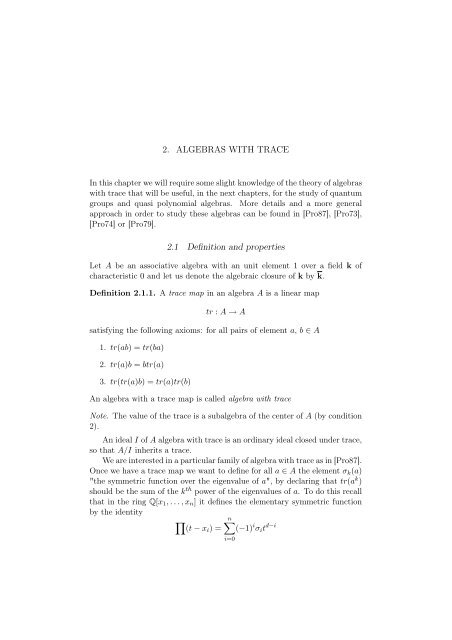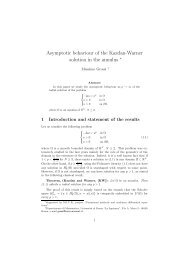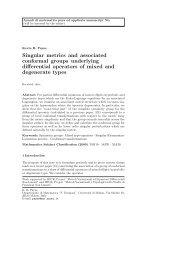Degree of Parabolic Quantum Groups - Dipartimento di Matematica ...
Degree of Parabolic Quantum Groups - Dipartimento di Matematica ...
Degree of Parabolic Quantum Groups - Dipartimento di Matematica ...
You also want an ePaper? Increase the reach of your titles
YUMPU automatically turns print PDFs into web optimized ePapers that Google loves.
2. ALGEBRAS WITH TRACE<br />
In this chapter we will require some slight knowledge <strong>of</strong> the theory <strong>of</strong> algebras<br />
with trace that will be useful, in the next chapters, for the study <strong>of</strong> quantum<br />
groups and quasi polynomial algebras. More details and a more general<br />
approach in order to study these algebras can be found in [Pro87], [Pro73],<br />
[Pro74] or [Pro79].<br />
2.1 Definition and properties<br />
Let A be an associative algebra with an unit element 1 over a field k <strong>of</strong><br />
characteristic 0 and let us denote the algebraic closure <strong>of</strong> k by k.<br />
Definition 2.1.1. A trace map in an algebra A is a linear map<br />
tr : A → A<br />
satisfying the following axioms: for all pairs <strong>of</strong> element a, b ∈ A<br />
1. tr(ab) = tr(ba)<br />
2. tr(a)b = btr(a)<br />
3. tr(tr(a)b) = tr(a)tr(b)<br />
An algebra with a trace map is called algebra with trace<br />
Note. The value <strong>of</strong> the trace is a subalgebra <strong>of</strong> the center <strong>of</strong> A (by con<strong>di</strong>tion<br />
2).<br />
An ideal I <strong>of</strong> A algebra with trace is an or<strong>di</strong>nary ideal closed under trace,<br />
so that A/I inherits a trace.<br />
We are interested in a particular family <strong>of</strong> algebra with trace as in [Pro87].<br />
Once we have a trace map we want to define for all a ∈ A the element σk(a)<br />
"the symmetric function over the eigenvalue <strong>of</strong> a", by declaring that tr(ak )<br />
should be the sum <strong>of</strong> the kth power <strong>of</strong> the eigenvalues <strong>of</strong> a. To do this recall<br />
that in the ring Q[x1, . . .,xn] it defines the elementary symmetric function<br />
by the identity<br />
n<br />
(t − xi) = (−1) i σit d−i<br />
i=0








